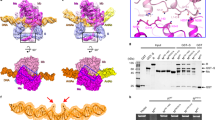Abstract
The Ocr antirestriction protein, which is encoded by bacteriophage T7 0.3 (ocr), specifically inhibits type I restriction-modification enzymes. Ocr belongs to a family of DNA-mimicking proteins. Native Ocr forms homodimers both in solution and in crystal. Ocr mutants with two amino acid substitutions (Orc F53D A57E and Ocr F53R V77D) were constructed to occur as monomers in solution. The dissociation constant K d for the Ocr complex with EcoKI (R2M2S) proved to differ by three orders of magnitude between the (Ocr)2 dimer and Ocr F53D A57E and Ocr F53R V77D monomers (10−10 M vs. 10−7 M). Antimodification activity was substantially lower in the Ocr monomers. The dimeric form found to be essential for high inhibitory activity of Ocr.
Similar content being viewed by others
References
Studier F.W. 1975. Gene 0.3 of bacteriophage T7 acts to overcome the DNA restriction system of the host. J. Mol. Biol. 94, 283–295.
Kruger D.H., Hansen S., Reiter M. 1983. The ocr gene function of bacteriophages T3 and T7 counteracts the Salmonella typhimurium DNA restriction systems SA and SB. J. Virol. 45, 1147–1149.
Dunn J.J., Elzinga M., Mark K.K., Studier F.W. 1981. Amino acid sequence of the gene 0.3 protein of bacteriophage T7 and nucleotide sequence of its messenger RNA. J. Biol. Chem. 256, 2579–2585.
Mark K.-K., Studier F.W. 1981. Purification of the gene 0.3 protein of bacteriophage T7, an inhibitor of the DNA restriction system of Escherichia coli. J. Biol. Chem. 256, 2573–2578.
Walkinshaw M.D., Taylor P., Sturrock S.S., Atanasiu C., Berge T., Henderson R.M., Edwardson J.M., Dryden D.T.F. 2002. Structure of Ocr from bacteriophage T7, a protein that mimics B-form DNA. Mol. Cell. 9, 187–194.
Atanasiu C., Byron O., McMiken H., Sturrock S.S., Dryden D.T.F. 2001. Characterisation of the structure of Ocr, the gene 0.3 protein of bacteriophage T7. Nucleic Acids Res. 29, 3059–3068.
Atanasiu C., Su T.-J., Sturrock S.S., Dryden D.T.F. 2002. Interaction of the Ocr gene 0.3 protein of bacteriophage T7 with EcoKI restriction-modification enzyme. Nucleic Acids Res. 30, 3936–3944.
Su T.-J., Tock M.R., Egelhaaf S.U., Poon W.C.K., Dryden D.T.F. 2005. DNA bending by M.EcoKI methyltransferase is coupled to nucleotide flipping. Nucleic Acids Res. 33, 3235–3244.
Stephanou A.S., Roberts G.A., Cooper L.P., Clarke D.J., Thomson A.R., MacKay C.L., Nutley M., Cooper A., Dryden D.T.F. 2009. Dissection of the DNA mimicry of the bacteriophage T7 Ocr protein using chemical modification. J. Mol. Biol. 391, 565–576.
Stephanou A.S., Roberts G.A., Tock M.R., Pritchard E.H., Turkington R., Nutley M., Cooper A., Dryden D.T.F. 2009. A mutational analysis of DNA mimicry by Ocr, the gene 0.3 antirestriction protein of bacteriophage T7. Biochem. Biophys. Res. Commun. 378, 129–132.
Roberts G.A., Stephanou A.S., Kanwar N., Dawson A., Cooper L.P., Chen K., Nutley M., Cooper A., Blakely G.W., Dryden D.T.F. 2012. Exploring the DNA mimicry of the Ocr protein of phage T7. Nucleic Acids Res. 40, 8129–8143.
Miller J.H. Experiments in Molecular Genetics. Cold Spring Harbor, NY: Dold Spring Harbor Lab. Press.
Lutz R., Bujard H. 1997. Independent and tight regulation of transcriptional units in Escherichia coli via the LacR/O, theTetR/O and AraCI1-I2 regulatory elements. Nucleic Acids Res. 25, 1203–1210.
Zavilgelsky G.B., Kotova V.Y., Rastorguev S.M. 2008. Comparative analysis of anti-restriction activities of ArdA (ColIb-P9) and Ocr (T7) proteins. Biochemistry (Moscow). 73, 906–911.
Delproposto J., Majmudar C.Y., Smith J.L., Brown W.C. 2009. Mocr: A novel fusion tag for enhancing solubility that is compatible with structural biology applications. Protein Exp. Purif. 63, 40–49.
Landt O., Grunert H.P., Hahn U. 1990. A general method for rapid site-directed mutagenesis using the polymerase chain reaction. Gene. 96, 125–128.
Sanger F., Nicklen S., Coulson A.R. 1977. DNA sequencing with chain-terminating inhibition. Proc. Natl. Acad. Sci. U. S. A. 74, 5463–5467.
Zavilgelsky G.B., Kotova V.Yu., Rastorguev S.M. 2009. Antirestriction and antimodification activities of T7 Ocr: Effects of amino acid substitutions in the interface. Mol. Biol. (Moscow). 43, 93–100.
Tock M.R., Dryden D.T. 2005. The biology of restriction and antirestriction. Curr. Opin. Microbiol. 8, 466–472.
Zavilgelsky G.B., Rastorguev S.M. 2007. DNA mimicry by proteins as effective mechanism for regulation of activity of DNA-dependent enzymes. Biochemistry (Moscow). 72, 913–919.
Thomas A.T., Brammar W.J., Wilkins B.M. 2003. Plasmid R16 ArdA protein preferentially targets restriction activity of the type I restriction-modification system EcoKI. J. Bacteriol. 185, 2022–2025.
Zavilgelsky G.B., Letutchaja T.A., Rastorguev S.M. 2004. Antirestriction activity of ArdA encoded by the IncI1 transmissive plasmid R64. Mol. Biol. (Moscow). 38, 765–769.
Author information
Authors and Affiliations
Corresponding author
Additional information
Original Russian Text © G.B. Zavilgelsky, V.Yu. Kotova, 2014, published in Molekulyarnaya Biologiya, 2014, Vol. 48, No. 1, pp. 176–184.
Rights and permissions
About this article
Cite this article
Zavilgelsky, G.B., Kotova, V.Y. Antirestriction activity of the monomeric and dimeric forms of T7 Ocr. Mol Biol 48, 150–157 (2014). https://doi.org/10.1134/S0026893313060174
Received:
Accepted:
Published:
Issue Date:
DOI: https://doi.org/10.1134/S0026893313060174



